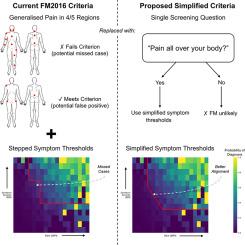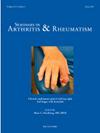优化纤维肌痛标准:来自英国生物银行的证据
IF 4.4
2区 医学
Q1 RHEUMATOLOGY
引用次数: 0
摘要
目的评估2016年修订的纤维肌痛标准(FM2016)在识别大样本人群中自我报告的纤维肌痛个体方面的表现,并测试简化的症状阈值和广泛疼痛的替代定义是否提高了病例发现效用。方法:我们使用了来自英国生物银行167,184名参与者的数据,他们完成了一份“疼痛体验”在线问卷。使用Logistic回归和临床效用指数(CUI+和CUI−)来评估FM2016标准的性能,以及在病例发现和筛选自我报告的纤维肌痛诊断方面的替代修改。FM2016量表、广泛疼痛指数(WPI)、症状严重程度量表(SSS)和多症状困扰量表(PSD)的截止组合进行迭代优化。我们还比较了广泛疼痛的不同定义,包括一个关于“全身疼痛”的自我报告项目。结果FM2016标准特异性高(98.4%),敏感性低(37.0%),病例发现效率低(CUI+= 0.111)。一套简化的标准,WPI≥4,SSS≥4,PSD≥12,以自我报告的全身慢性疼痛为条件,提高了病例发现效用(CUI+= 0.163),同时保持了高筛查能力(CUI−= 0.974)。其他对广泛性疼痛的定义表现得不那么好。结论:在这项以人群为基础的大型研究中,简化的标准包含一个关于广泛疼痛的单一问题和更容易应用的症状界限,在识别FM诊断方面表现略好。本文章由计算机程序翻译,如有差异,请以英文原文为准。

Optimising fibromyalgia criteria: evidence from the UK Biobank
Objective
To evaluate the performance of the 2016 revisions to the modified fibromyalgia criteria (FM2016) in identifying individuals with self-reported fibromyalgia in a large population sample, and to test whether simplified symptom thresholds and alternative definitions of widespread pain improve case-finding utility.
Methods
We used data from 167,184 UK Biobank participants who completed an “Experience of Pain” online questionnaire. Logistic regression and clinical utility indices (CUI+ and CUI−) were used to assess the performance of the FM2016 criteria and alternative modifications in case-finding and screening self-reported fibromyalgia diagnoses. Cut-off combinations for the scales of the FM2016, the Widespread Pain Index (WPI), Symptom Severity Scale (SSS), and the Polysymptomatic Distress Scale (PSD) were iteratively optimised. We also compared different definitions of widespread pain, including a single self-reported item on “pain all over the body”.
Results
The FM2016 criteria showed high specificity (98·4 %) but low sensitivity (37·0 %) and case-finding utility (CUI+=0·111). A simplified set of criteria, WPI≥4, SSS≥4, and PSD≥12, conditional on self-reported chronic pain all over the body, improved case-finding utility (CUI+=0·163) while maintaining high screening ability (CUI−=0·974). Other definitions of widespread pain performed less well.
Conclusion
In this large population-based study, simplified criteria incorporating a single question on widespread pain and easier-to-apply symptom cut-offs performed marginally better in identifying those with a diagnosis of FM.
求助全文
通过发布文献求助,成功后即可免费获取论文全文。
去求助
来源期刊
CiteScore
9.20
自引率
4.00%
发文量
176
审稿时长
46 days
期刊介绍:
Seminars in Arthritis and Rheumatism provides access to the highest-quality clinical, therapeutic and translational research about arthritis, rheumatology and musculoskeletal disorders that affect the joints and connective tissue. Each bimonthly issue includes articles giving you the latest diagnostic criteria, consensus statements, systematic reviews and meta-analyses as well as clinical and translational research studies. Read this journal for the latest groundbreaking research and to gain insights from scientists and clinicians on the management and treatment of musculoskeletal and autoimmune rheumatologic diseases. The journal is of interest to rheumatologists, orthopedic surgeons, internal medicine physicians, immunologists and specialists in bone and mineral metabolism.

 求助内容:
求助内容: 应助结果提醒方式:
应助结果提醒方式:


